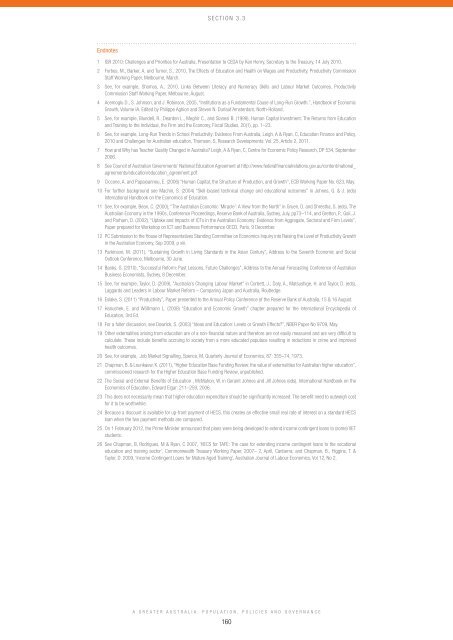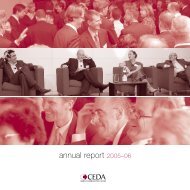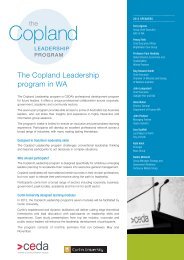A Greater Australia: Population, policies and governance - CEDA
A Greater Australia: Population, policies and governance - CEDA
A Greater Australia: Population, policies and governance - CEDA
- No tags were found...
You also want an ePaper? Increase the reach of your titles
YUMPU automatically turns print PDFs into web optimized ePapers that Google loves.
Section 3.3Endnotes1 IGR 2010: Challenges <strong>and</strong> Priorities for <strong>Australia</strong>, Presentation to <strong>CEDA</strong> by Ken Henry, Secretary to the Treasury, 14 July 2010.2 Forbes, M., Barker, A. <strong>and</strong> Turner, S., 2010, The Effects of Education <strong>and</strong> Health on Wages <strong>and</strong> Productivity, Productivity CommissionStaff Working Paper, Melbourne, March.3 See, for example, Shomos, A., 2010, Links Between Literacy <strong>and</strong> Numeracy Skills <strong>and</strong> Labour Market Outcomes, ProductivityCommission Staff Working Paper, Melbourne, August.4 Acemoglu D., S. Johnson, <strong>and</strong> J. Robinson, 2005, “Institutions as a Fundamental Cause of Long-Run Growth.”, H<strong>and</strong>book of EconomicGrowth, Volume IA. Edited by Philippe Aghion <strong>and</strong> Steven N. Durlauf Amsterdam, North-Holl<strong>and</strong>.5 See, for example, Blundell, R., Dearden L., Meghir C., <strong>and</strong> Sianesi B. (1999), Human Capital Investment: The Returns from Education<strong>and</strong> Training to the Individual, the Firm <strong>and</strong> the Economy, Fiscal Studies, 20(1), pp. 1–23.6 See, for example, Long-Run Trends in School Productivity: Evidence From <strong>Australia</strong>, Leigh, A & Ryan, C, Education Finance <strong>and</strong> Policy,2010 <strong>and</strong> Challenges for <strong>Australia</strong>n education, Thomson, S, Research Developments: Vol. 25, Article 2, 2011.7 How <strong>and</strong> Why has Teacher Quality Changed in <strong>Australia</strong>? Leigh, A & Ryan, C, Centre for Economic Policy Research, DP 534, September2006.8 See Council of <strong>Australia</strong>n Governments’ National Education Agreement at http://www.federalfinancialrelations.gov.au/content/national_agreements/education/education_agreement.pdf9 Ciccone, A. <strong>and</strong> Papaioannou, E. (2006) “Human Capital, the Structure of Production, <strong>and</strong> Growth”, ECB Working Paper No. 623, May.10 For further background see Machin, S. (2004) “Skill-biased technical change <strong>and</strong> educational outcomes” in Johnes, G. & J. (eds)International H<strong>and</strong>book on the Economics of Education.11 See, for example, Bean, C. (2000), “The <strong>Australia</strong>n Economic ‘Miracle’: A View from the North” in Gruen, D. <strong>and</strong> Shrestha, S. (eds), The<strong>Australia</strong>n Economy in the 1990s, Conference Proceedings, Reserve Bank of <strong>Australia</strong>, Sydney, July, pp73–114, <strong>and</strong> Gretton, P., Gali, J.<strong>and</strong> Parham, D. (2002), “Uptake <strong>and</strong> Impacts of ICTs in the <strong>Australia</strong>n Economy: Evidence from Aggregate, Sectoral <strong>and</strong> Firm Levels”,Paper prepared for Workshop on ICT <strong>and</strong> Business Performance OECD, Paris, 9 December.12 PC Submission to the House of Representatives St<strong>and</strong>ing Committee on Economics Inquiry into Raising the Level of Productivity Growthin the <strong>Australia</strong>n Economy, Sep 2009, p xiii.13 Parkinson, M. (2011), “Sustaining Growth in Living St<strong>and</strong>ards in the Asian Century”, Address to the Seventh Economic <strong>and</strong> SocialOutlook Conference, Melbourne, 30 June.14 Banks, G. (2010), “Successful Reform: Past Lessons, Future Challenges”, Address to the Annual Forecasting Conference of <strong>Australia</strong>nBusiness Economists, Sydney, 8 December.15 See, for example, Taylor, D. (2009), “<strong>Australia</strong>’s Changing Labour Market” in Corbett, J., Daly, A., Matsushige, H. <strong>and</strong> Taylor, D. (eds),Laggards <strong>and</strong> Leaders in Labour Market Reform – Comparing Japan <strong>and</strong> <strong>Australia</strong>, Routledge.16 Eslake, S. (2011) “Productivity”, Paper presented to the Annual Policy Conference of the Reserve Bank of <strong>Australia</strong>, 15 & 16 August.17 Hanushek, E. <strong>and</strong> Wößmann L. (2008) “Education <strong>and</strong> Economic Growth” chapter prepared for the International Encyclopedia ofEducation, 3rd Ed.18 For a fuller discussion, see Dowrick, S. (2003) “Ideas <strong>and</strong> Education: Levels or Growth Effects?”, NBER Paper No 9709, May.19 Other externalities arising from education are of a non-financial nature <strong>and</strong> therefore are not easily measured <strong>and</strong> are very difficult tocalculate. These include benefits accruing to society from a more educated populace resulting in reductions in crime <strong>and</strong> improvedhealth outcomes.20 See, for example, .Job Market Signalling, Spence, M, Quarterly Journal of Economics, 87: 355–74, 1973.21 Chapman, B. & Lounkaew, K. (2011),“Higher Education Base Funding Review: the value of externalities for <strong>Australia</strong>n higher education”,commissioned research for the Higher Education Base Funding Review, unpublished.22 The Social <strong>and</strong> External Benefits of Education , McMahon, W. in Geraint Johnes <strong>and</strong> Jill Johnes (eds), International H<strong>and</strong>book on theEconomics of Education, Edward Elgar: 211–259, 2006.23 This does not necessarily mean that higher education expenditure should be significantly increased. The benefit need to outweigh costfor it to be worthwhile.24 Because a discount is available for up-front payment of HECS, this creates an effective small real rate of interest on a st<strong>and</strong>ard HECSloan when the two payment methods are compared.25 On 1 February 2012, the Prime Minister announced that plans were being developed to extend income contingent loans to (some) VETstudents.26 See Chapman, B, Rodrigues, M & Ryan, C 2007, ‘HECS for TAFE: The case for extending income contingent loans to the vocationaleducation <strong>and</strong> training sector’, Commonwealth Treasury Working Paper, 2007– 2, April, Canberra; <strong>and</strong> Chapman, B., Higgins, T. &Taylor, D. 2009, ‘Income Contingent Loans for Mature Aged Training’, <strong>Australia</strong>n Journal of Labour Economics, Vol 12, No 2.A <strong>Greater</strong> <strong>Australia</strong>: <strong>Population</strong>, Policies <strong>and</strong> Governance160





